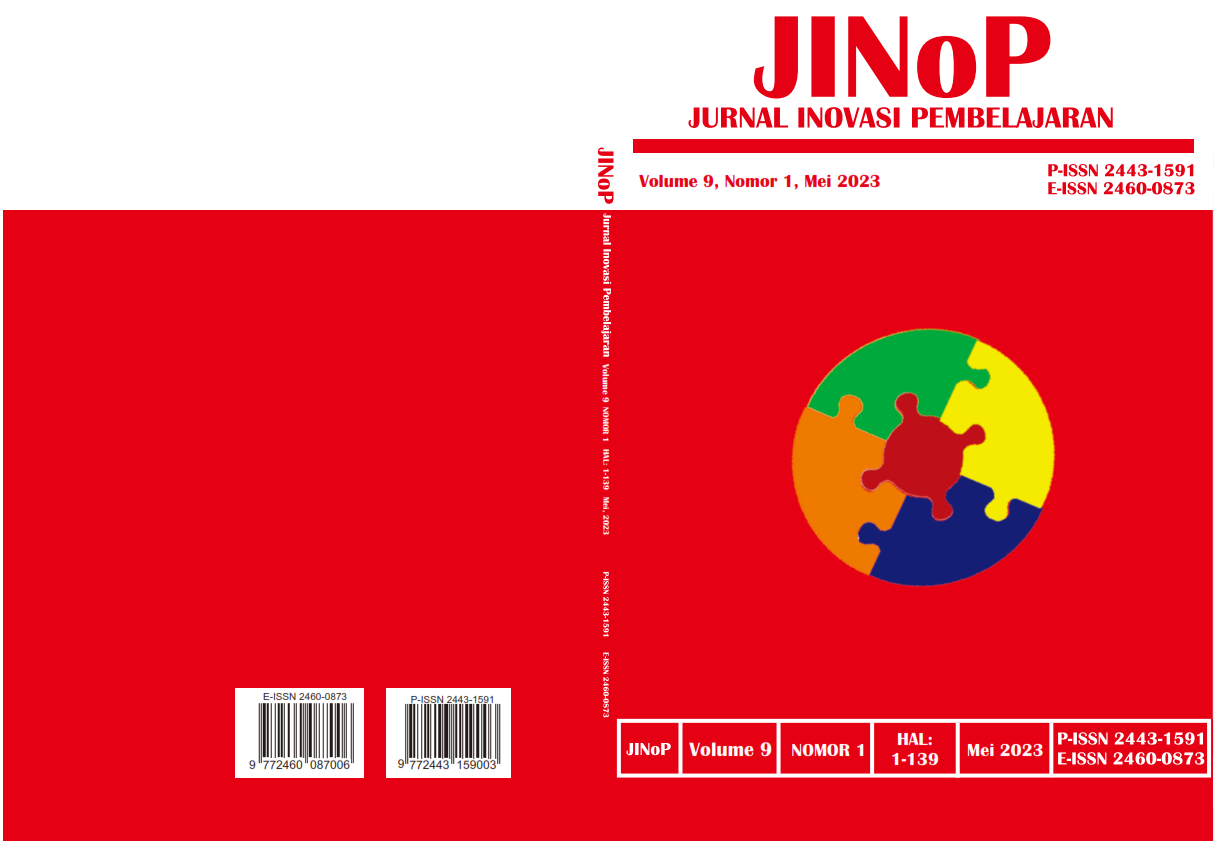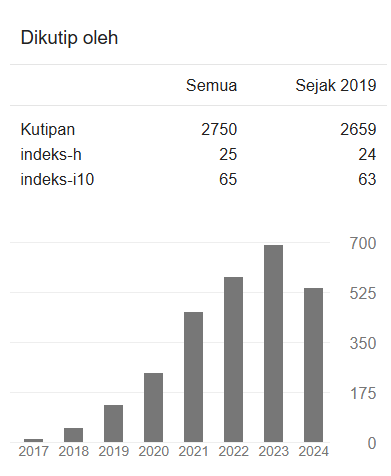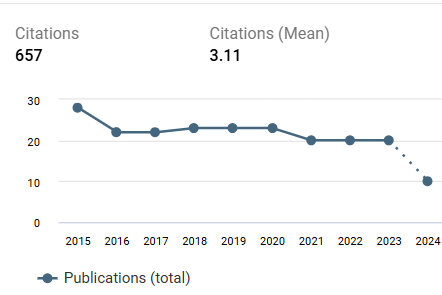Pengembangan Bahan ajar transformasi geometri berbantuan website: Pendekatan Project-Based-Learning Mozaik Geometri
DOI:
https://doi.org/10.22219/jinop.v9i1.23581Keywords:
Teaching Materials, Website, Geometry Mosaic, Project-Based-LearningAbstract
The digital era positively impacts all aspects of life, including education. Current learning requires teachers to use technology. Technology in learning mathematics is needed, especially in geometry material. The basic concept in geometry is the ability to visualize. An excellent understanding of visualization will help students understand geometric concepts. This study aims to develop teaching materials for geometry transformation material assisted by a website with a project-based learning approach using a geometric mosaic model that the eligibility criteria for teaching materials; therefore, it can be used in teaching and learning. Research and development with the ADDIE model are conducted in this study, which consists of phases: Analysis, Design, Development, Implementation, and Evaluation. The instruments used were expert/practitioner content validation sheets and student construct validation sheets; the instrument was developed using seven aspects. Teaching materials are validated by experts and also assessed by students. Based on the results of the assessment of 7 experts/experts, it was shown that the geometry transformation teaching material obtained very appropriate criteria with an assessment percentage of 85%. In contrast, the assessment of 28 Al Hasra Depok High School students showed good criteria with an assessment percentage value of 80%. Therefore, researchers can recommend website-assisted geometry transformation teaching materials using a project-based learning approach, "geometry mosaic," which can complement existing teaching materials and be used in mathematics learning activities, especially at the high school level.
Downloads
References
Aghnia, R. B., Dwirahayu, G., & Firdausi. (2022). Pengembangan modul realistic mathematics education berbantuan QR code pada materi relasi dan fungsi. Algoritma, 4(1), 79–92. https://journal.uinjkt.ac.id/index.php/algoritma/article/view/25621
Dwirahayu, G., Handayani, I. D., Suhyanto, O., Musyrifah, E., & Sobiruddin, D. (2022). Development of mathematics teaching-learning material with metaphors approach. Journal of Physics: Conference Series, 2157(1). https://doi.org/10.1088/1742-6596/2157/1/012045
Dwirahayu, G. (2012). Pengaruh Strategi Pembelajaran Eksploratif terhadap Peningkatan Kemampuan Visualisasi dan Pemahaman Konsep Geometri. JPPM, 5(2), 107–124.
Fadli. (2014). Pengembangan Model Pembelajaran Berbasis Web untuk Pelajaran Matematika. Jurnal Teknologi Pendidikan, 16(1), 13–23. https://journal.unj.ac.id/unj/index.php/jtp/article/view/5400/4029
Fauziah Y. (2020). Metode Pembelajaran Berbasis Web (E-Learning) Dalam Proses Belajar Mengajar Secara Virtual. Jurnal Terapung: Ilmu-Ilmu Sosial, 2(2), 35–44. https://ojs.uniska-bjm.ac.id/index.php/terapung/article/view/3975
Fitriyah, D. N., Santoso, H., & Suryadinata, N. (2018). Bahan Ajar Transformasi Geometri Berbasis Discovery Learning melalui Pendekatan Etnomatematika. Jurnal Elemen, 4(2), 145. https://doi.org/10.29408/jel.v4i2.705
Gdfio. (2022). Tassellazione da copiare. https://id.pinterest.com/pin/tassellazione-da-copiare--162200024069267045/ diakses tanggal 29 Nopember 2022
Gunawan, S. H., Harjono, A., & Ni Made Yeni Suranti. (2017). The effect of project based learning with virtual media assistance on student's creativity in physics. Cakrawala Pendidikan, 36(2), 167–179. https://journal.uny.ac.id/index.php/cp/article/view/13514
Hasnawati, H., & Anggraini, D. (2018). Mozaik sebagai Sarana Pengembangan Kreativitas Anak Dalam Pembelajaran Seni Rupa menggunakan Metode Pembinaan Kreativitas Dan Keterampilan. Jurnal PGSD, 9(2), 226–235. https://doi.org/10.33369/pgsd.9.2.226-235
Januarisman, E., & Ghufron, A. (2016). Pengembangan Media Pembelajaran Berbasis Web Mata Pelajaran Ilmu Pengetahuan Alam Untuk Siswa Kelas Vii. Jurnal Inovasi Teknologi Pendidikan, 3(2), 166. https://doi.org/10.21831/jitp.v3i2.8019
Karssenberg, G. (2014). Learning Geometry by Designing Persian Mosaics. For the Learning of Mathematics, 34(1), 43–49. https://flm-journal.org/Articles/2E0CB6E94D76C79C2F341680D60F17.pdf
Laily, I. N. (2021). Karya Seni Mozaik, Sejarah, Bahan, Cara Membuat dan Contohnya Artikel ini telah tayang di Katadata.co.id dengan judul “Karya Seni Mozaik, Sejarah, Bahan, Cara Membuat dan Contohnya” , https://katadata.co.id/safrezi/berita/61bac5003d6ae/karya-seni-mozaik-s. https://katadata.co.id/safrezi/berita/61bac5003d6ae/karya-seni-mozaik-sejarah-bahan-cara-membuat-dan-contohnya
Lalian, O. N. (2018). The effects of using video media in mathematics learning on students' cognitive and affective aspects. AIP Conference Proceedings, 2019(October 2018). https://doi.org/10.1063/1.5061864
Mutimmah, D., & Rifa’i, P. B. (2017). Pemodelan motif keramik dengan teknik penggabungan bangun-bangun geometri datar dengan konsep transformasi. AKSIOMA: Jurnal Program Studi Pendidikan Matematika, 6(3), 407–413. https://ojs.fkip.ummetro.ac.id/index.php/matematika/article/view/1156
Nurhayati, A. S., & Harianti, D. (2019). Rancangan Model Pembelajaran Berbasis Proyek (Project Based Learning) PjBL yang Memanfaatkan Rumah Belajar. https://rest-app.belajar.kemdikbud.go.id/files/pdf/5f11e04dc7904d5c82c7bfb6ec63379c.pdf
Parzysz, B. (2009). Using Key Diagrams to Design and Construct Roman Geometric Mosaics? Nexus Network Journal, 1(2), 273–287. https://doi.org/10.1007/978-3-7643-8976-5
Perbawa, I., Warpala, I., & Agustin, K. (2020). Pengembangan Bahan Ajar Berbasis proyek pada mata pelajaran elektronika dasar. Jurnal Teknologi Pembelajaran Indonesia, 10(2), 96–104. https://doi.org/https://doi.org/https://doi.org/10.23887/jtpi.v10i2.3396
Pratikna, D. S., Sugiatno, S., & Hartoyo, A. (2020). Pengembangan Instrumen Eksplorasi Konsep Geometri Berstruktur Dari Teori Van Hiele Berbantuan Software GeoGebra. Jurnal AlphaEuclidEdu, 1(2), 121. https://doi.org/10.26418/ja.v1i2.42881
Putri, I. T., Aminoto, T., & Pujaningsih, F. B. (2020). Pengembangan E-Modul Fisika Berbasis Pendekatan Saintifik Pada Materi Teori Kinetik Gas. EduFisika, 5(01), 52–62. https://doi.org/10.22437/edufisika.v5i01.7725
Radiusman, & Juniati, D. (2022). Kajian Etnomatematika kain tenun Lombok berdasarkan pola geometri wallpaper dan geometri frieze. AKSIOMA: Jurnal Program Studi Pendidikan Matematika, 11(3), 1909–1923. https://doi.org/http://dx.doi.org/10.24127/ajpm.v11i3.5329
Satriawati, G., Dwirahayu, G., & Mardiyah, Y. (2021). Pengembangan bahan ajar bangun ruang sisi datar menggunakan strategi thinking maps. Algoritma, 3(2), 199–213. https://journal.uinjkt.ac.id/index.php/algoritma/article/view/23721
Setiawan, W. (2017). Era Digital dan Tantangannya. Seminar Nasional Pendidikan. Seminar Nasional Pendidikan, 1–9. https://core.ac.uk/works/43969438
Solichah, S. (2017). Keterampilan Mozaik (1st ed.). Yogyakarta: Indopublika.
Sukmawati, A., Rahman, T., Giyartini, R., Studi, P., Upi, P., & Tasikmalaya, K. (2021). Media Mozaik Untuk Memfasilitasi Perkembangan Motorik Halus Anak Usia 4-5 Tahun: Tinjauan Literatur Sistematis. Jurnal Paud Agapedia, 5(2), 246–252. https://ejournal.upi.edu/index.php/agapedia/article/view/40924
Swoboda, E., & Vighi, P. (2016). Early Geometrical Thinking in the Environment of Patterns, Mosaics and Isometries (Issue October). https://doi.org/10.1007/978-3-319-44272-3_1
Syafrijal, & Desyandri. (2019). Deveopment Of Integrated Thematic Teaching Materials With Project Based Learning Models In Class IV of Primary School. International Journal of Educational Dynamics/IJEDS, 1(2), 87–92. https://doi.org/https://doi.org/10.24036/ijeds.v1i2.110
Tambunan, H. (2013). Pengembangan pembelajaran berbasis website dalam mata kuliah pengaturan mesin listrik. Cakrawala Pendidikan, 1, 64–75. https://doi.org/https://doi.org/10.21831/cp.v5i1.1260
Tegeh, I. M., Jampel, I. N., & Pudjawan, K. (2014). Model penelitian pengembangan (1st ed.). Yogyakarta: Graha Ilmu.
Yunita, Y., Juandi, D., Hasanah, A., & Tamur, M. (2021). Studi Meta-Analisis: Efektivitas Model Project-Based Learning Terhadap Kemampuan Berpikir Kreatif Matematis Siswa. AKSIOMA: Jurnal Program Studi Pendidikan Matematika, 10(3), 1382. https://doi.org/10.24127/ajpm.v10i3.3705
Downloads
Published
How to Cite
Issue
Section
License
Copyright (c) 2023 Satriawati et al

This work is licensed under a Creative Commons Attribution 4.0 International License.
Copyright Notice
Authors who publish with JINoP (Jurnal Inoasi Pembelajaran) agree to the following terms:
- For all articles published in the JINoP (Jurnal Inovasi Pembelajaran), copyright is retained by the authors. Authors give permission to the publisher to announce the work with conditions. When the manuscript is accepted for publication, the authors agree to the automatic transfer of the publishing right to the publisher.
- Authors retain copyright and grant the journal the right of first publication with the work simultaneously licensed under a Creative Commons Attribution 4.0 International License. that allows others to share the work with an acknowledgment of the work's authorship and initial publication in this journal.
- Authors are able to enter into separate, additional contractual arrangements for the non-exclusive distribution of the journal's published version of the work (e.g., post it to an institutional repository or publish it in a book), with an acknowledgment of its initial publication in this journal.
- Authors are permitted and encouraged to post their work online (e.g., in institutional repositories or on their website) prior to and during the submission process, as it can lead to productive exchanges, as well as earlier and greater citation of published work (See The Effect of Open Access).








